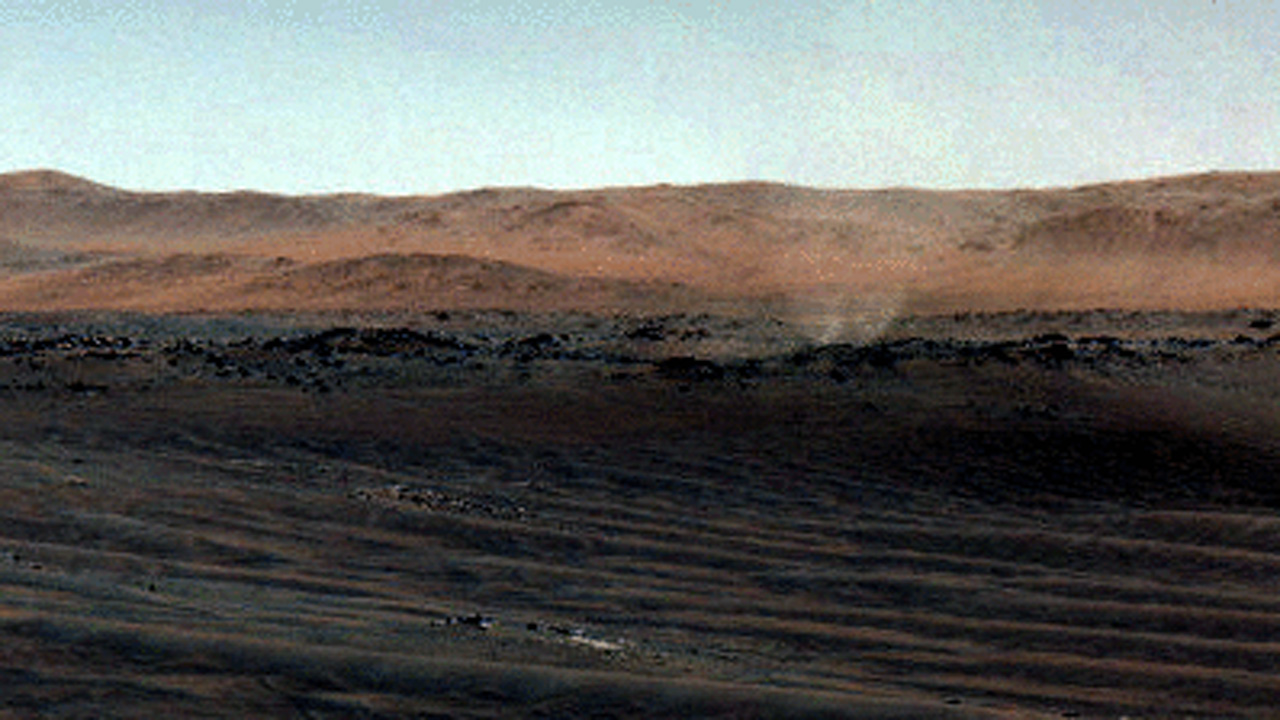NASA's Mars Perseverance rover records 1st-ever audio of Red Planet dust devil
The audio reveals perplexing details about the anatomy of a dust devil.
Perseverance has captured the sound of dust grains impacting the NASA rover, and the recording could be key to understanding how dust is transported around Mars.
The recording comes from a microphone on the Perseverance rover's SuperCam instrument on Sept. 27, 2021, during sol 215 of the rover's mission. (A sol is a Martian day and about 40 minutes longer than a day on Earth.) Other instruments also detected the dust devil, which features in images from Perseverance's NavCam and temperature and pressure measurements from Perseverance's Mars Environmental Dynamics Analyzer (MEDA). Plus, the scientists were able to use the microphone to accurately measure wind speeds based on the intensity of the sound of the gusts.
The rover had already detected 90 dust devils passing overhead, but this event was the first time Perseverance was fortunate enough to have its microphone switched on at the time.
"With this dust-devil recording, we can actually hear and count particles impacting the rover," Naomi Murdoch, a planetary scientist at the Institut Supérieur de l'Aéronautique et de l'Espace (ISAE–SUPAERO) at the University of Toulouse in France and lead author of the study, told Space.com.
Related: Mars dust storm mysteries remain as scientists study the Red Planet

Taking everything into account — the audio recording, the images, and the temperature and pressure measurements — Murdoch and her colleagues determined that the dust devil was about 82 feet (25 meters) across and at least 387 feet (118 m) tall, moving at 17 feet (5.3 m) per second.
Based on the number of impacts, the sound recordings quantified for the first time ever the wind-blown dust grains in a dust devil. The recording includes a total of 308 impacts on the rover from dust grains carried by the winds of the dust devil, and these impacts were distributed in three bunches. The first group occurred when the whirling leading edge of the dust devil started passing over Perseverance, and the third group came when the trailing edge reached the rover, with concentrations of dust in the walls of the vortex.
Get the Space.com Newsletter
Breaking space news, the latest updates on rocket launches, skywatching events and more!
However, the most impacts by far occurred when the low-pressure center of the vortex was swirling above Perseverance, which came as a puzzling surprise.
Ordinarily, one would expect most of the dust to be concentrated in the walls of the dust devil, where the wind speeds are high. The center of a dust devil, like the eye of a storm, should, in comparison to the vortex's walls, be relatively calm and clear.
In this particular dust devil, however, there seemed to be a concentration of dust in the middle of the vortex. And the oddity wasn't a fluke in the recording since Perseverance's NavCam also spotted this internal dust.
"This particular dust devil is unusual even for Mars," Murdoch said. "We aren't entirely sure why the dust has accumulated in the center, but it may be because the dust devil is still in its initial phase of formation."
Perseverance's landing site, Jezero Crater, lies near one of the tracks of the big seasonal dust storms and experiences an abundance of dust devils compared to Elysium Planitia, where NASA's InSight lander touched down in November 2018; that spacecraft hasn't detected a single dust devil to date.
It's not just atmospheric scientists who wish InSight had better dust devil luck. The lander's solar panels are now covered in too much dust to enable the mission to continue much longer and in the experience of previous missions such as the Spirit and Opportunity rovers, dust devils can blow dust from solar arrays.
Previous work has shown that dust devils and isolated wind gusts are responsible for maintaining a significant amount of dust in the Martian atmosphere even outside of dust-storm season. Yet how much dust devils contribute and the process by which they loft the dust off the ground remains uncertain, which is why finding a dust devil with this extra dust in the middle could be an important piece of the jigsaw.
"We still do not fully understand how, exactly, dust is lifted from the surface of Mars," Murdoch said.
The findings illustrate the importance of the sonic environment as a new frontier for planetary scientists to explore.
Murdoch was part of the team at ISAE–SUPAERO who designed and built the microphone for Perseverance's SuperCam instrument, and the intention was always to use it to try to hear dust devils. However, with each microphone recording session lasting only 167 seconds, the odds were low that the microphone would be switched on at the same time a dust devil swept over the rover. But the slim chances did not dissuade Murdoch.
"Within our team at ISAE–SUPAERO we were convinced that a microphone on Mars would be an important instrument, and we haven't been disappointed," she said.
The results are described in a paper published Tuesday (Dec. 13) in Nature Communications.
Follow Keith Cooper on Twitter @21stCenturySETI. Follow us on Twitter @Spacedotcom and on Facebook.
Join our Space Forums to keep talking space on the latest missions, night sky and more! And if you have a news tip, correction or comment, let us know at: community@space.com.

Keith Cooper is a freelance science journalist and editor in the United Kingdom, and has a degree in physics and astrophysics from the University of Manchester. He's the author of "The Contact Paradox: Challenging Our Assumptions in the Search for Extraterrestrial Intelligence" (Bloomsbury Sigma, 2020) and has written articles on astronomy, space, physics and astrobiology for a multitude of magazines and websites.









